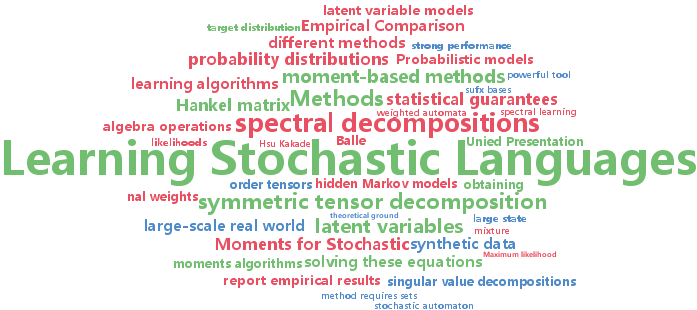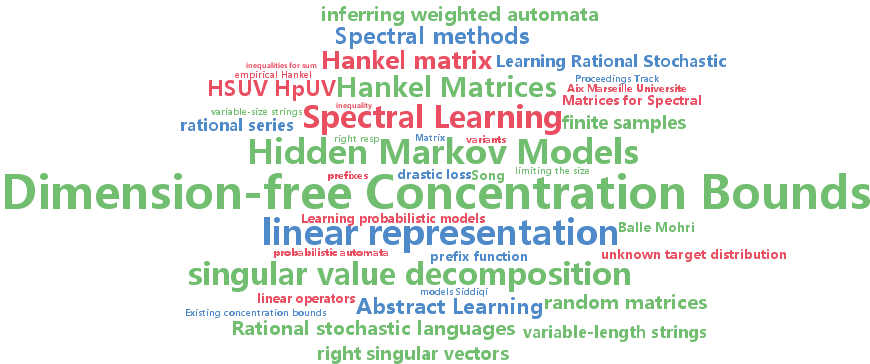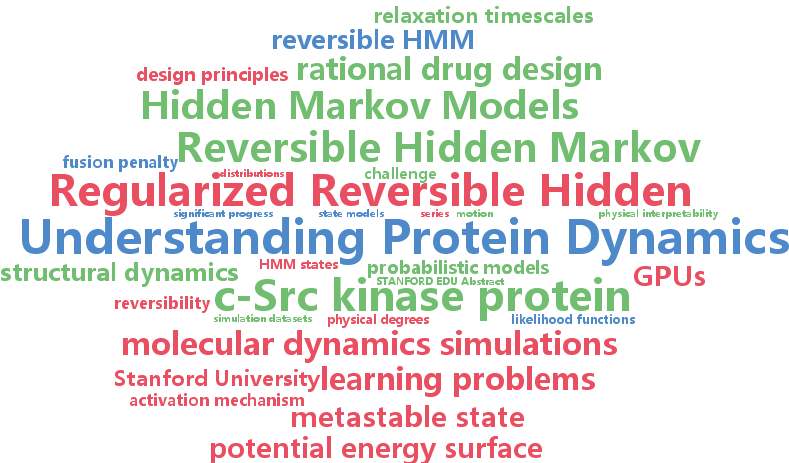hidden markov models
-
Borja Balle and William Hamilton and Joelle Pineau
Methods of Moments for Learning Stochastic Languages: Unified Presentation and Empirical Comparison (pdf)
Probabilistic latent-variable models are a powerful tool for modelling structured data. However, traditional expectation-maximization methods of learning such models are both computationally expensive and prone to local-minima. In contrast to these traditional methods, recently developed learning algorithms based upon the method of moments are both computationally efficient and provide strong statistical guarantees. In this work, we provide a unified presentation and empirical comparison of three general moment-based methods in the context of modelling stochastic languages. By rephrasing these methods upon a common theoretical ground, introducing novel theoretical results where necessary, we provide a clear comparison, making explicit the statistical assumptions upon which each method relies. With this theoretical grounding, we then provide an in-depth empirical analysis of the methods on both real and synthetic data with the goal of elucidating performance trends and highlighting important implementation details.
-
Aonan Zhang and Jun Zhu and Bo Zhang
Max-Margin Infinite Hidden Markov Models (pdf)
Infinite hidden Markov models (iHMMs) are nonparametric Bayesian extensions of hidden Markov models (HMMs) with an infinite number of states. Though flexible in describing sequential data, the generative formulation of iHMMs could limit their discriminative ability in sequential prediction tasks. Our paper introduces max-margin infinite HMMs (M2iHMMs), new infinite HMMs that explore the max-margin principle for discriminative learning. By using the theory of Gibbs classifiers and data augmentation, we develop efficient beam sampling algorithms without making restricting mean-field assumptions or truncated approximation. For single variate classification, M2iHMMs reduce to a new formulation of DP mixtures of max-margin machines. Empirical results on synthetic and real data sets show that our methods obtain superior performance than other competitors in both single variate classification and sequential prediction tasks.
-
François Denis and Mattias Gybels and Amaury Habrard
Dimension-free Concentration Bounds on Hankel Matrices for Spectral Learning (pdf)
Learning probabilistic models over strings is an important issue for many applications. Spectral methods propose elegant solutions to the problem of inferring weighted automata from finite samples of variable-length strings drawn from an unknown target distribution. These methods rely on a singular value decomposition of a matrix $H_S$, called the Hankel matrix, that records the frequencies of (some of) the observed strings. The accuracy of the learned distribution depends both on the quantity of information embedded in $H_S$ and on the distance between $H_S$ and its mean $H_r$. Existing concentration bounds seem to indicate that the concentration over $H_r$ gets looser with its size, suggesting to make a trade-off between the quantity of used information and the size of $H_r$. We propose new dimension-free concentration bounds for several variants of Hankel matrices. Experiments demonstrate that these bounds are tight and that they significantly improve existing bounds. These results suggest that the concentration rate of the Hankel matrix around its mean does not constitute an argument for limiting its size.
-
Robert McGibbon and Bharath Ramsundar and Mohammad Sultan and Gert Kiss and Vijay Pande
Understanding Protein Dynamics with L1-Regularized Reversible Hidden Markov Models (pdf)
We present a machine learning framework for modeling protein dynamics. Our approach uses L1-regularized, reversible hidden Markov models to understand large protein datasets generated via molecular dynamics simulations. Our model is motivated by three design principles: (1) the requirement of massive scalability; (2) the need to adhere to relevant physical law; and (3) the necessity of providing accessible interpretations, critical for rational protein engineering and drug design. We present an EM algorithm for learning and introduce a model selection criteria based on the physical notion of relaxation timescales. We contrast our model with standard methods in biophysics and demonstrate improved robustness. We implement our algorithm on GPUs and apply the method to two large protein simulation datasets generated respectively on the NCSA Bluewaters supercomputer and the Folding@Home distributed computing network. Our analysis identifies the conformational dynamics of the ubiquitin protein responsible for signaling, and elucidates the stepwise activation mechanism of the c-Src kinase protein.



